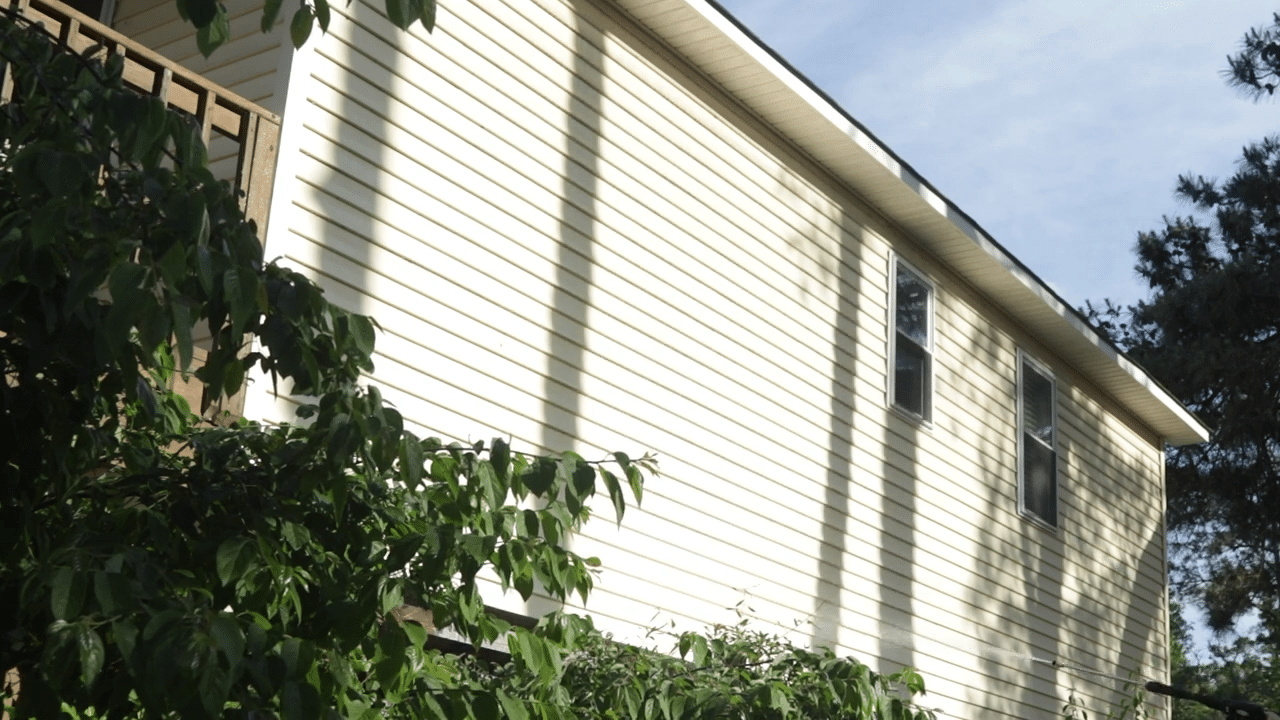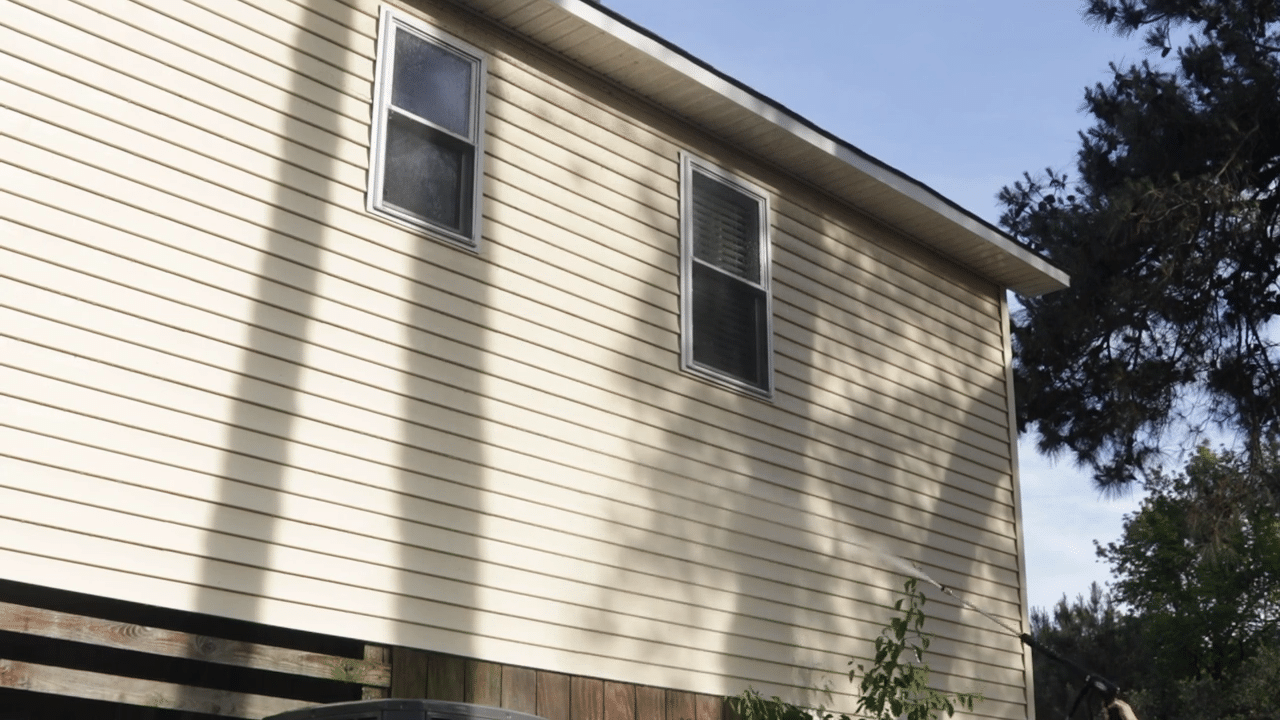How To Pressure Wash A House To Clean Siding
Today you’re going to learn how to pressure wash your house to clean the siding and gutters with the best pressure washer.
How to Clean Siding with a Pressure Washer
- Select and get a gas pressure washer for the job
Gas-powered pressure washers have more power and longer duty cycles compared to electric models. Look for a washer with 2500-3000 PSI for cleaning siding. The higher pressure helps blast away tough grime.

- Purchase Exterior Cleaning Chemical
We like 30-Second Outdoor Cleaner. This is a fast-acting formula that cuts through dirt and grime quickly without scrubbing. Always follow manufacturer guidelines for wait time.

- Spray Water on Plants to Protect Landscaping
Before applying chemicals, use a hose or pressure washer with a soap dispenser to spray down all landscaping, plants, grass, mulch beds, etc. adjacent to the siding. This will help protect from chemical overspray.

- Install Soap Nozzle
Locate the soap nozzle attachment that came with your pressure washer accessories. Remove any existing nozzle from the end of the wand if necessary. Attach and twist tight the soap nozzle, which has a wider fan spray pattern to disperse chemicals.

- Apply Chemicals to the Siding
Starting at the top, apply chemicals liberally across all surfaces of the siding working from top to bottom. Let sit for 5 minutes (or follow instructions for the cleaner if using something other than 30-seconds outdoor cleaner).

- Rinse the Siding
Replace the soap nozzle with a pressure nozzle. Rinse thoroughly from top to bottom, ensuring all soap and debris is removed. Use an extension wand if needed for tall/multi-story buildings.

Best Power Washer, Attachments and Detergents To Clean Your House Siding
The correct pressure washer, with the right attachments and detergents will help you clean your entire house in one afternoon. Let’s look at the tools and materials you’ll want to have before starting:
How To Know if You Need Gas or Electric Powered?
A heavy-duty gas powered pressure washer is ideal. Why? Because cleaning your house is a big job and the higher the flow rate (GPM) the quicker you can get the job done.

What PSI and GPM?
You will want a power cleaner with at least 2.3 GPM. The PSI is irrelevant for this job because the nozzle and how far you hold the wand from the surface will determine it. All the pressure washers with 2.3 GPM have at least 2,600 PSI.
Which Nozzle?
You will need to use the black soaping nozzle to apply the detergent. Then to pressure wash the house siding clean use either the 25 or 40 degree nozzle tip. To pressure clean the higher up areas you will want to use an extension wand because you want to avoid using a ladder with a pressure cleaner. Always hold the pressure wand 3 feet from the surface to start and move closer to 1-foot as you watch how much force is required to remove mildew and grime. The detergent should work its magic to make very little pressure required.
Do I Need Detergent?
Absolutely. Detergent is necessary because it will make the job simple. Without it you risk damaging your house siding because more water force will be required to remove the dirt and grime. There are specific detergent solutions formulated for cleaning your house siding – whether it be vinyl, stucco, brick or wood. Make sure you only purchase environmentally friendly solutions.

Should I Use a Brush Attachment?
Although not required it will improve the cleaning capacity and performance of your power washing. A brush attachment will allow you to push and scrub the dirt and grime away with the bristles of the brush. You can purchase one for less than $40 and use it to clean wheelie garbage bins, cars and boats.
What About An Extension Wand?
An extension wand will make your power washing easy if you have a two story house. There are additional attachments that you can put on the end of the extension wand to allow you to clean the gutters out while standing safely on the ground. Safety is number 1 and that is why we recommend the use of a telescoping extension wand.
What To Do Before You Start Pressure Washing Your House
The last thing you want is to cause damage or get injured when power cleaning your home exterior. Here are some simple things to do to ensure you complete the job without injury. Do these and you will be able to admire your work while sipping a cold one at the end of job.
Use Eye Protection
Eye protection is mandatory. It’s scary because you would never see guys in a machine shop working without eye protection but then you will always see DIY’ers and people working around their homes without eye protection. Super simple to just wear a pair of safety rated sunglasses to avoid eye injuries.
Avoid Ladders
You want to avoid using a pressure cleaner from a ladder because the push back from the wand may cause you to lose balance and fall. You will not see commercial pressure washers using a ladder because it is a safety risk and who wants to risk their life while on the job, right? In industry people will use elevated work platform vehicles, scaffolding, rope access techniques or simply use extension wands.

Be Aware of Power Lines
Some houses are connected to power lines above ground or have power lines running along the edge of their property. Are you one of these people? If you are just be aware that you don’t attach the extension wand and then touch the wand to the power line risking electrocution.
Clear The Area
Another super simple thing to do is clear the area of toys, bikes etc to avoid forgetting about them and tripping over them. Also clear the bottom part of your house siding of bushes so you can pressure clean those dirty bottom areas.
Do You Have Lead Paint?
Lead paint was banned for residential use in 1978. Still, some homes exist with lead paint exteriors because they haven’t been touched since then. If you think you may have lead paint you need to follow your local building codes to get rid of it.
Tip: Hire someone to take care of it. It is highly dangerous to ingest (you or your pet) lead paint chips by accident or inhale the dust from sanding it away.
How To Know If There is Asbestos?
Asbestos is still legal in the USA for some uses. The main issue with asbestos is breathing in the fibres that can be released from damaged asbestos surfaces when disturbed. Now, you most likely do not have asbestos on your home’s exterior but if your house is really old (pre-1970s) and you have what appears to be concrete panels at the base of your home and those are damaged it is worth getting those tested to see if it is asbestos.
Water and Electricity Don’t Mix
Turn off the power at the distribution board to all the outdoor electrical outlets – especially if they are not fitted with waterproof covers. If you leave the electrical on and water gets into them it could damage your home’s electricity system.
Take Note of Vents and Openings
Avoid or cover vents and openings to avoid getting water into your home interior. Use plastic and tape.
How Often Should You Pressure Wash Your House?
Our guidance is to pressure wash your home exterior every 2 years at least.
How To Deal With Different Types of House Siding
For the most part, the only difference between different types of house siding is which detergent you use. Each type of siding will have a specially formulated solution to properly clean it. In addition, follow these tips before pressure cleaning your house siding:
- Vinyl Siding – Repair any damaged siding before pressure washing. Avoid where the panels overlap like into the door or window frames.
- Aluminium Siding – Avoid angling the power spray up under the panel overlaps.
- Fibre Cement Siding – Repair damaged areas before starting.
- Wood Siding – Fix or repair any cracked or damaged wood panels and be sure to wet the surface before applying detergent.
- Stucco Siding – Repair any chips or cracks before cleaning. To avoid damaging the surface hold the pressure washer 2 feet from the surface and use a 25 or 40 degree nozzle.
- Brick and Stone Siding – Patch and repair any damaged joints before you begin to clean. Spray down the brick before starting with a light spray from the garden hose to prevent the detergent getting deep into the brick.



![[Solution] My Pressure Washer Loses Pressure When the Trigger is Pulled](https://pressurewashr.com/wp-content/uploads/2021/06/Losing-Pressure-Thumb-768x453.png)



